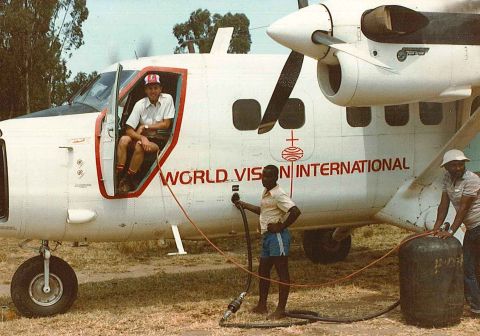World Vision brings BBC reporter back to Ethiopia
Reporter Mike Wooldridge, who with fellow BBC journalist Mike Buerk broke the infamous famine story on October 23, 1984, has returned to Ethiopia with World Vision.
During three days in late October 1984, Wooldridge, Buerk, and cameraman Mohammed Amin flew in World Vision's planes between Addis Ababa and northern towns of Mekelle, Korem, and Alamata.
During their visits, the reporters documented the hordes of emaciated and sick people huddled in makeshift feeding shelters, waiting for help.
Upon their return to London, 30 years ago on October 23, the three journalists told the story of a “biblical famine” endangering the country.
Their reporting opened the world’s eyes to the plight of millions of Ethiopians devastated by years of drought. It inspired a global wave of aid and support, including unprecedented fundraising by the era’s biggest music stars.
The BBC tracks Woolridge's return to Ethiopia.
Pilots carrying life-saving food remember
For about 12 hours a day, Will Rew and Keith Ketchum ferried emergency food and supplies to far-flung communities stricken by drought and famine. Each flight of their DeHavilland Twin Otter airplane could haul up to two tonnes of food to help people stave off hunger, sickness and death.
While they were just following orders, Ketchum remembers being a little miffed October 19, 1984, when asked to take BBC reporters, rather than food, to communities in the north where the drought’s devastating effects were being felt most severely.

Will Rew sits in the cockpit of one of the Twin Otter airplanes used to provide emergency food, as well as shuttle the BBC journalists to the scene where they captured footage to alert the world of what was going on. (Photo: Keith Ketchum)
“We despised journalists because they (each) weighed 70-75 kilos,” says Ketchum, half-joking. “So we’d have to leave (behind) a bag of grain.”
As quickly as they came, the journalists were gone, and Rew and Ketchum returned to their life-saving missions. “We could tell people, ‘yes, indeed, aid is getting to the people — we dropped it off this morning,’” says Ketchum.
Still haunted by the mothers' eyes
Tesfatsian Dalellow, an Ethiopian national, was working for World Vision in New Zealand at the time. He was flown back to Ethiopia the day after the story broke, to help lead World Vision's response.
Today, he says he is still haunted by that time. "All the eyes of the mothers were on you. Moving wherever you were going. And the infants, the children, their mouths... were gasping... and from that, you had to make a choice."
I left immediately and was met with horror, it was a killer, the memories of choosing who should be fed, the mother eyes on you the whole time, as you marked those who would live," he recalls.
Tesfatsian Dalellow talks to World Vision about those days.
Food security in Ethiopia
World Vision has worked in Ethiopia for the 30 years since this time, and have worked with many people who well remember their struggles during that time.
Abebe was 20-years-old in 1984. He watched the drought as it dried out his land, starved his daughter and killed his crops. Without much hope for their future, he took his young family to World Vision's emergency feeding centre -- where their fortune changed.
"My experiences during the famine were terrible - horrifying. We didn’t have any hope and we didn’t expect to ever survive. We never expected rain to come. So this (he lifts his arms to his farm) is an entirely different story."
Now Abebe is a model farmer in Antsokia, producing famous crops that bring buyers far and wide to purchase them. He grows beautiful mangoes, onions, coffee beans, papaya, bananas -- fruits he'd never heard of as a boy.
"When World Vision moved into the development phase of their work, I became one of the five model farmers around here. They gave us farm tools and seedlings and we started growing tomato and cabbage and other foods as they trained us. We began to learn how to grow mangoes and bananas and other foods, and that is how this garden is possible today... It’s really incredible the change that I’ve seen from the famine and I’m really very grateful."
Abebe stands in his fertile fields in Antsokia Valley. Photo by Alexander Whittle
In the decades since the catastrophic drought, World Vision has worked with Ethiopia’s government and hard-hit communities to empower families to improve their lives. Transformation is evident in the lush green farmlands and forests that cover Korem, the Antsokia Valley, and other places.
“Today, children and their families no longer suffer from food insecurity,” says Margaret Schuler, World Vision’s National Director in Ethiopia. “This is an amazing accomplishment. We regularly hear of farmers producing surplus as crop production in the region has increased by 100% in the last five years alone.”
With files from Georgina Newman and Chris Huber